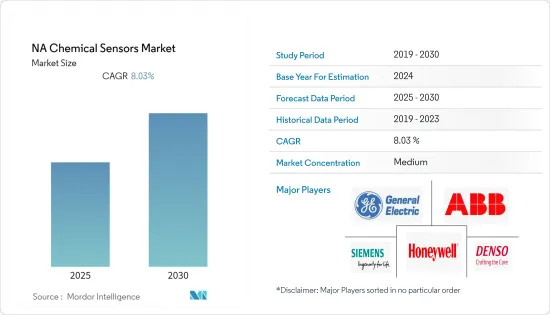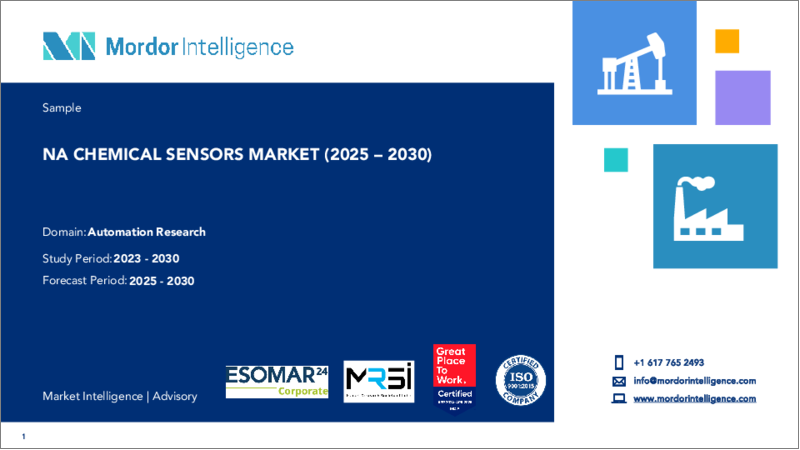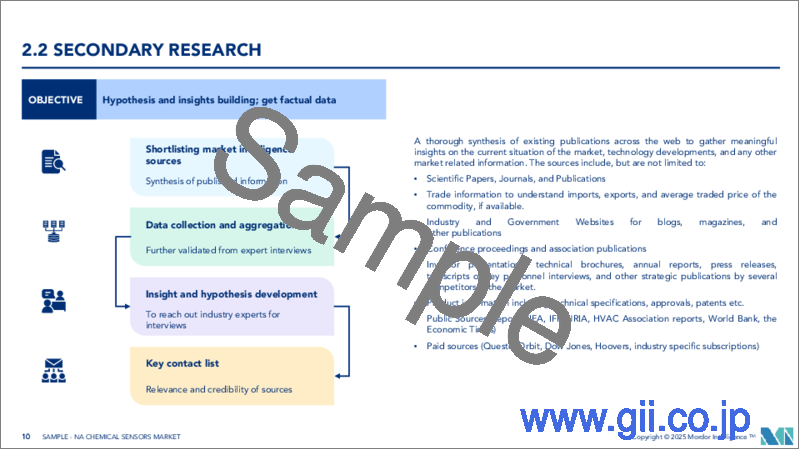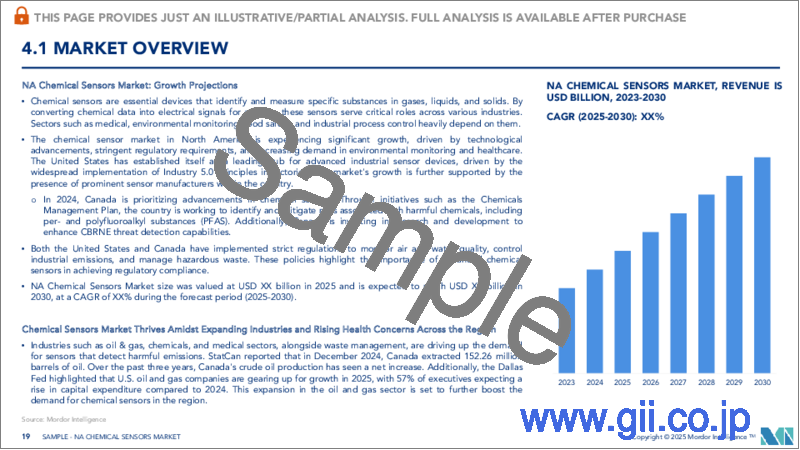|
|
市場調査レポート
商品コード
1626321
北米の化学センサー:市場シェア分析、産業動向、統計、成長予測(2025~2030年)NA Chemical Sensors - Market Share Analysis, Industry Trends & Statistics, Growth Forecasts (2025 - 2030) |
||||||
カスタマイズ可能
適宜更新あり
|
|||||||
| 北米の化学センサー:市場シェア分析、産業動向、統計、成長予測(2025~2030年) |
|
出版日: 2025年01月05日
発行: Mordor Intelligence
ページ情報: 英文 110 Pages
納期: 2~3営業日
|
全表示
- 概要
- 目次
概要
北米の化学センサー市場は予測期間中にCAGR 8.03%を記録する見込み

主なハイライト
- 様々な材料の化学組成を分析する化学センサーの能力が、その採用を促進しています。化学センシングアレイと高次直交センサーは、業界の2大開発です。化学センサーは、その低コストと携帯性から普及が拡大すると予測されます。
- 環境への懸念は別として、化学工業プロセスにおける分析対象物のための化学センサーの利用が牽引力を増しています。センサーは、防衛分野、研究所、ヘルスケア事業で先進ツールとして使用されており、これが市場を牽引しています。
- 人口の増加と医療への関心の高まりにより、病気を治すためのこれらのセンサーの使用が大幅に増加すると予想されます。これにより、血糖値モニタリングなどさまざまな臨床用途で使用されるセンサーの需要が増加し、医薬品アプリケーションの開発に役立ちます。
- COVID-19の流行により、自動車、石油・ガスなどいくつかの分野の成長が鈍化しています。化学物質ベースのセンサーは石油・ガス分野で最も多く使用されています。石油・ガスセクター全体の既存および計画中の多くのプロジェクトが、COVID-19の流行の結果、プロジェクトの計画と実行の面で問題に遭遇しており、化学ベースのセンサーの貢献の減少につながっています。
北米の化学センサー市場動向
医療分野における化学センサーの急速な普及
- センサーは、物理的、化学的、生物学的信号を検出し、そのような信号の測定と記録を可能にする装置です。医療、研究、環境モニタリング、自動生産など、さまざまな分野で採用されています。例えば、化学センサーは、Ca+濃度、PH値、グルコース濃度などの体液の成分や濃度を検出するために使用されます。抗原、酵素、抗体、DNA、RNA、ホルモン、微生物などはすべてバイオセンサーによって検出されます。
- 肺がんなどの病気は、がんに関連した死亡率で世界で最も多いです。患者の予後と治療法は、がんのステージ、組織学、遺伝子変化によって決定されます。交差反応性化学センサーナノアレイを用いて、呼気サンプルおよび体外肺がん細胞株のヘッドスペース中の揮発性バイオマーカーを同定しました。
- さらに、吸収と蛍光は光学化学センシングで利用される最も一般的な物理現象であるが、化学ルミネッセンス、ラマン散乱、プラズモン共鳴も利用されています。光の強度は、調査対象のパラメータ(光学的特性を持つ)によって、あるいは光学的特性が調査対象のパラメータの濃度によって変動する化学変換器によって直接調節されます。
広範な産業における化学センサーの有益な使用法
- 旺盛な消費者需要と購買力平価は、米国の自動車産業における基礎的な需要パターンを後押ししています。自動車産業におけるセンサーと測定技術の使用強化は、エンジン性能の向上、エネルギー経済性の向上、汚染排出の低減をもたらしました。
- 自動車空調制御用の新しい大気質センサーが開発されました。この化学センサーは、チャコールフィルターと吸気フラップを備えた空調システムでの使用を目的としています。NOxとCOは大気汚染を検出するための最も重要なマーカーです。
- 自動車の燃焼エンジンを効果的に管理するためには、高感度の化学センサーが必要です。酸素モニタリング用の各種セラミック製ラムダプローブは、ガソリンとディーゼルの両用途で十分に確立されています。公害規制の強化や車載診断に伴い、新たな排気ガス種のモニタリングへの関心は高まり続けています。この進歩の結果、特にディーゼル・アプリケーション向けに新世代の排ガスセンサーが開発されています。
北米の化学センサー産業概要
北米の化学センサー市場は部分的に断片化されています。同市場の主要企業には、Honeywell International Inc., Denso Corporation, ABB Ltd., Siemens AG, General Electric Co.などがあります。この分野での戦略的イニシアチブは以下の通り:
- 2021年6月、ゼネラル・エレクトリック社は、あらゆる天候や現場状況において有害な化学物質の存在を第一応答者に早期に警告する小型蒸気化学剤検知器(CVCAD)を開発中です。
- 2021年6月、米国防総省の小型蒸気化学剤検知器(CVCAD)プログラムでは、Teledyne Technologies Incorporatedの一部門であるTeledyne FLIRが、米国軍初の大量装着型化学剤検知器の製造契約を獲得しました。同社は400万米ドルの初期投資を受けました。
その他の特典:
- エクセル形式の市場予測(ME)シート
- 3ヶ月間のアナリスト・サポート
目次
第1章 イントロダクション
- 調査の前提条件と市場定義
- 調査範囲
第2章 調査手法
第3章 エグゼクティブサマリー
第4章 市場洞察
- 市場概要
- バリューチェーン/サプライチェーン分析
- 業界の魅力度-ポーターのファイブフォース分析
- 新規参入業者の脅威
- 買い手の交渉力
- 供給企業の交渉力
- 代替品の脅威
- 競争企業間の敵対関係の強さ
- COVID-19の業界への影響評価
第5章 市場力学
- 市場促進要因
- 化学センサー技術の技術開発の増加
- 化学センサーの採用用途の増加
- 市場抑制要因
- 技術的な複雑さ
第6章 市場セグメンテーション
- 製品タイプ別
- 電気化学
- 光学式
- パリスター/触媒ビーズ
- その他の製品タイプ
- 用途別
- 医療用
- 石油・ガス
- 環境モニタリング
- 自動車
- 産業用
- その他
- 国別
- 米国
- カナダ
- メキシコ
- その他北米地域
第7章 競合情勢
- 企業プロファイル
- Honeywell International Inc.
- Denso Corporation
- ABB Ltd.
- Siemens AG
- General Electric Co.
- Teledyne Technologies Incorporated
- Smiths Detection Inc.
- Chemring Group PLC
- Bosch Sensortec GmbH
- Smart Sensors, Inc.
第8章 投資分析
第9章 市場の将来
目次
Product Code: 47458
The NA Chemical Sensors Market is expected to register a CAGR of 8.03% during the forecast period.

Key Highlights
- The capacity of chemical sensors to analyze the chemical composition of various materials is driving their adoption. Chemical sensing arrays and higher-order orthogonal sensors are two major industry developments. Chemical sensors are projected to expand in popularity due to their low cost and portability.
- Aside from environmental concerns, the use of chemical sensors for analytes in chemical industrial processes is gaining traction. Sensors are being used as advanced tools in the defense sector, research labs, and healthcare operations, which is driving the market.
- The rising population and growing medical concerns are expected to result in a significant increase in the use of these sensors to heal illnesses. This will increase demand for sensors used in a variety of clinical applications, such as blood glucose monitoring, and will aid in the development of pharmaceutical applications.
- The COVID-19 epidemic has slowed the growth of several sectors, including automobiles, oil and gas, and others. Chemical-based sensors are most often used in the oil and gas sector. Many existing and planned projects across the oil and gas sector are encountering issues in terms of project planning and execution as a result of the COVID-19 epidemic, leading to a diminished contribution of chemical-based sensors.
North America Chemical Sensors Market Trends
Rapid Growing Adoption of Chemical Sensors in Medical
- Sensors are devices that detect physical, chemical, and biological signals and allow for the measurement and recording of such signals. They've been employed in a variety of sectors, including medical, research, environmental monitoring, and automated production. A chemical sensor, for example, is used to detect the constituent and concentration of bodily fluids such as Ca+ concentration, PH value, glucose concentration, and so on. Antigen, enzyme, antibody, DNA, RNA, hormone, and microorganism are all detected by the biosensor.
- Disease like Lung cancer is the most common cancer-related mortality in the world. The prognosis and therapy of a patient are determined by cancer's stage, histology, and genetic alterations. Cross-reactive chemical sensor nanoarrays were used to identify volatile biomarkers in breath samples and the headspace of in-vitro lung cancer cell lines.
- Furthermore, absorption and fluorescence are the most common physical phenomena utilized in optical chemical sensing; however, chemical luminescence, Raman scattering, and plasmon resonance have also been used. The intensity of the light is directly regulated by the parameter being researched (which possesses optical characteristics) or by a chemical transducer whose optical properties fluctuate with the concentration of the parameter under examination in optical sensors.
Beneficial Usage of Chemical Sensors in Wide-ranging Industries
- Strong consumer demand, along with purchasing power parity, is boosting underlying demand patterns in the automobile industry in the United States, which is, in turn, impacting the expansion of chemical sensors in this industry. Enhanced usage of sensor and measuring technologies in the automobile industry has resulted in improved engine performance, increased energy economy, and lower pollution emissions.
- A novel air quality sensor for automotive climate control has been developed. The chemical sensor is intended for use in air conditioning systems with a charcoal filter and an air intake flap. NOx and CO are the most important markers for detecting air pollution.
- Chemical sensors with high sensitivity are required to manage automobile combustion engines effectively. Various types of ceramic lambda probes for oxygen monitoring are well established for both gasoline and diesel applications. Interest in monitoring new exhaust gas species continues to develop in the face of stricter pollution laws and on-board diagnostics. As a result of this advancement, new generations of exhaust gas sensors are being developed, particularly for diesel applications.
North America Chemical Sensors Industry Overview
North America Chemical Sensors Market is partially fragmented. Some of the major players in the market are Honeywell International Inc., Denso Corporation, ABB Ltd., Siemens AG, General Electric Co., and others. Some of the strategic initiatives made in this sector are:
- In June 2021, General Electric is developing a Compact Vapor Chemical Agent Detector (CVCAD) that will give first responders an early warning of the presence of harmful chemicals in all weather and field circumstances.
- In June 2021, Under the Pentagon's Compact Vapor Chemical Agent Detector (CVCAD) program, Teledyne FLIR, a division of Teledyne Technologies Incorporated, was awarded a contract to build the first mass-wearable chemical detector for US troops. The firm received an initial investment of US$ 4.0 million.
Additional Benefits:
- The market estimate (ME) sheet in Excel format
- 3 months of analyst support
TABLE OF CONTENTS
1 INTRODUCTION
- 1.1 Study Assumptions and Market Definition
- 1.2 Scope of the Study
2 RESEARCH METHODOLOGY
3 EXECUTIVE SUMMARY
4 MARKET INSIGHTS
- 4.1 Market Overview
- 4.2 Value Chain / Supply Chain Analysis
- 4.3 Industry Attractiveness - Porter's Five Force Analysis
- 4.3.1 Threat of New Entrants
- 4.3.2 Bargaining Power of Buyers
- 4.3.3 Bargaining Power of Suppliers
- 4.3.4 Threat of Substitute Products
- 4.3.5 Intensity of Competitive Rivalry
- 4.4 Assessment of COVID-19 Impact on the Industry
5 MARKET DYNAMICS
- 5.1 Market Drivers
- 5.1.1 Increasing Technological Development in Chemical Sensing Technologies
- 5.1.2 Increasing Applications for adoption of Chemical Sensors
- 5.2 Market Restraints
- 5.2.1 Technical Complications
6 MARKET SEGMENTATION
- 6.1 By Product Type
- 6.1.1 Electrochemical
- 6.1.2 Optical
- 6.1.3 Pallister/Catalytic Bead
- 6.1.4 Other Product Types
- 6.2 By Application
- 6.2.1 Medical
- 6.2.2 Oil and Gas
- 6.2.3 Environmental Monitoring
- 6.2.4 Automotive
- 6.2.5 Industrial
- 6.2.6 Others
- 6.3 By Country
- 6.3.1 United States
- 6.3.2 Canada
- 6.3.3 Mexico
- 6.3.4 Rest of North America
7 COMPETITIVE LANDSCAPE
- 7.1 Company Profiles
- 7.1.1 Honeywell International Inc.
- 7.1.2 Denso Corporation
- 7.1.3 ABB Ltd.
- 7.1.4 Siemens AG
- 7.1.5 General Electric Co.
- 7.1.6 Teledyne Technologies Incorporated
- 7.1.7 Smiths Detection Inc.
- 7.1.8 Chemring Group PLC
- 7.1.9 Bosch Sensortec GmbH
- 7.1.10 Smart Sensors, Inc.





